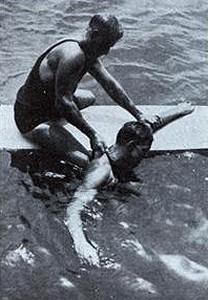surfresearch.com.au
 |
surfresearch.com.au
paul gartner
: surfboard riding hints, 1937
|
Paul
W.
Gartner : These simple hints will help you learn Surfboard
Riding, 1937.
Gartner, Paul W.:
: These simple hints will help
you learn Surfboard Riding
Popular Science
Volume 131 Number 1, July 1937
Modern Mechanix Blog
http://blog.modernmechanix.com/issue/?pubname=PopularScience&pubdate=7-1937
Introduction
Page 24
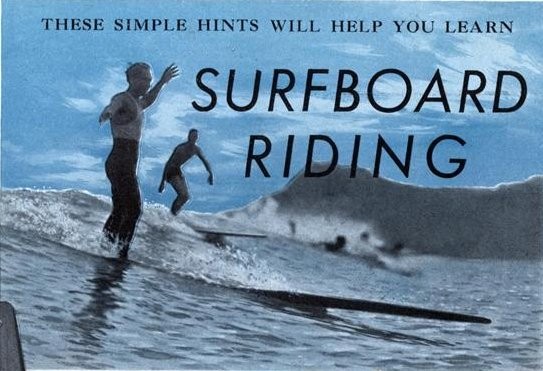
 |
WHERE the sea
throws itself shoreward in smooth, powerful swells,
you will find the wave riders— bronzed, muscular
swimmers who have studied well the whims of Father
Neptune and know how to hitch their buoyant surfboards
to the bounding water.
Their shouts ring out
above the thunder of breakers, as they stand upright
on the polished planes of wood and rocket along on the
forward slope of a swiftly advancing wave.
Merely to witness a
masterful performance of wave riding imparts some of
the delicious thrill known to these aquatic
artists.
And, if you are at all
addicted to water sports, you will feel a commanding
urge to duplicate their feats.
Before you do, however,
it will be well to learn from the beginning some of
the fine points in the ancient art of hitching a
ride on the waves.
Most surfboards range
from ten to twenty-one feet in length, by eighteen
to twenty-four inches in width, and weigh anywhere
between thirty and 165 pounds, depending upon the
material and type of construction.
For wave riding,
preference is given the shorter board, generally
under thirteen or fourteen feet, since it is more
easily handled.
Boards of greater length
are usually to be associated only with veteran
riders, who are likely to own a number of surfboards
of varied design.
The longest boards,
twenty or more feet in length and only eighteen
inches in width, are used more for paddling races
than for actual surf riding.
|
[Above:] Cigar shaped boards of
the air-chambered design.
The longer board is used
principally for paddling races.
Choose your
board according to your size and weight.
A youngster
may find an eight-foot board quite adequate, while a tall,
200-pound man may have his best success with an
air-chambered board not shorter than twelve feet.
The average
person will not be making a mistake if he practices with a
surfboard somewhere between ten and twelve feet long,
approximately twenty-two inches wide, and weighing not more
than fifty pounds.
In this
classification you have a choice between the traditional
ten-foot board, usually built of light balsa wood, and the
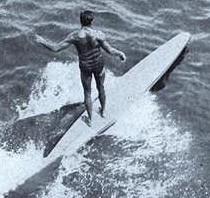
|
Most paddlers stroke
simultaneously. as shown below.
In
the photograph at the left, note the sideways
standing position,
which
permits the weight to be shifted easily to the
front or back of the surfboard.
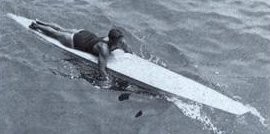
|
| Page
25 [By Paul W. Gartner}
more
modern cigar-shaped board, which contains an air
chamber throughout its entire length.
Once
you have selected a good surfboard, it is advisable
that you first become a competent paddler.
Prone
upon your stomach, balance your weight on the board
so that the deck is almost level with the
water.
A
choppy surface will require a slight uptilt to the
bow.
Now,
arch your back and raise your shoulders with face
forward, and start to stroke with extended arms, as
though they were the oars of a boat.
Most
paddlers, especially beginners, prefer to stroke
simultaneously with both arms, although an
alternating, over-arm stroke, similar to that used
in swimming the crawl, also can be employed.
It
is interesting diversion, too, to paddle
Indian-style on the knees, or in a sitting position.
|
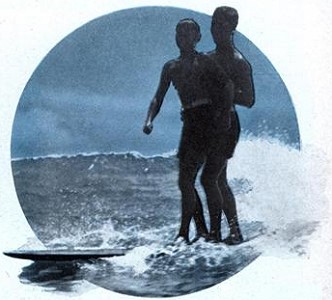 In tandem riding, the "passenger"
rides
In tandem riding, the "passenger"
rides
in
front of the steersman.
|
But whatever
the method, the stroke is made with the wrist and arm tensed,
and fingers cupped together.
Relax as the
arm is being carried forward.
On the hollow
racing boards, practiced paddlers can sprint at approximately
twice the speed of champion swimmers.
Distance also
is possible on the paddle board.
Beach guards
of Santa Monica, Calif., recently paddled from the mainland to
Santa Catalina Island, a distance of more than twenty-six
miles, in less than six hours.
The paddle
board also suggests adventure on lakes and broad rivers.
When resting,
merely sit upright on the board, astraddle near the point of
balance.
When
paddling, you have two methods of guiding your thin craft.
To negotiate
a slight curve, it is necessary only to vary the power of
your strokes, or to dip one hand shallowly as you increase
the force of the other.
But in order
to turn sharply, it may be advisable to drag one foot as
well.
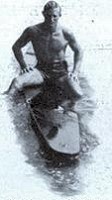
To rest, sit straddle
of the bouyant
board.
|
Most buoyant boards will carry two
persons on a favorable surface, and you and a
companion may paddle tandem fashion, timing your
strokes rhythmically like members of a rowing
crew.
The
more experienced person should ride behind and
act. as steersman.
The
paddle board can be used to advantage in
accomplishing a water rescue, particularly where
a swimmer has become tired and is unable to
return to shore without assistance.
Should
the subject be helpless, it is recommended that
you sit astraddle the board when attempting to
drag his weight into an advantageous position.
The
beginner should exercise caution when taking a
surfboard through the breakers.
Always
keep the bow headed squarely into the incoming
waves, and time your progress so that the
curling water will not crash down upon
you.
You
may buck through breakers that are largely
spent, but watch out for those which still have
a forceful rumble.
Where
waves are breaking is the real danger
zone.
|
When
attempting to pass a breaker at “this point, it generally is
advisable to slip from your board and, holding it firmly by
the stern, drive it deeply into the rolling water, ducking as
the crest of the wave sweeps over you.
Should you
happen to lose hold of your craft, remain submerged until the
breaker has passed, and even then come up with your arms above
your head.
Strong men
have been knocked unconscious when struck by a runaway
surfboard.
Now that you
have become familiar with the buoyant surfboard, you must
learn to judge waves.
Except when
swells are uncommonly high and steep, the best point to catch
a wave is just outside the area where local breaks begin.
Where there
are shoals you will find the first crests of white water.
Heavy ground
swells generally run in series, and most riders prefer to let
the first one or two go by, since the later waves usually are
smoother and better for riding.
It is the
habit of these largest waves first to break locally, and the
white crests will gain breadth in accordance with the
shallowing water.
It is on this
smooth “shoulder” beside the foam that surfboards slide to the
greatest advantage.
In hitching to
a wave, it is important that you keep your board at right
angles to the advancing slope of water.
Keep well back
on your water sled, so that the bow will ride fairly high,
particularly if the wave is steep.
Try to paddle
at approximately
Continued page 111.
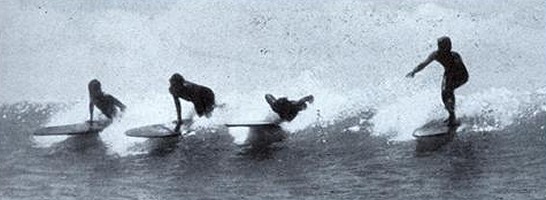 The light hollow surfboard is
easily carried on the shoulder.
The light hollow surfboard is
easily carried on the shoulder.
At
the left, four riders have caught a wave and are
are seen in the art of rising to their feet.
|
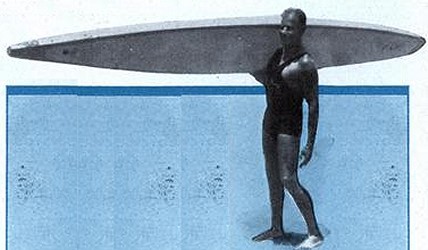 |
Page 111
Continued
from page 25.
|
In rescuing a swimmer , it is
best
to straddle the board
while
dragging his weight.
|
the speed of the
swell.
As the stern lifts, throw your weight slightly
forward in order to gain a final impetus for the
slide.
If all is well, you now will start to glide down the
slope of water, just as a toboggan speeds down an
icy hillside.
Once under way at a
pace that drives wind and spray whistling by your
ears, your first maneuver is to “slide,” or angle to
one side, away from the break of the wave.
This may be accomplished simply by shifting your
weight and, if the board fails to respond instantly,
using a foot as a rudder.
Failure to come into a slide sometimes causes a
board to dive, especially on steep waves.
On this initial ride you probably will be content to
maintain a prone position, but continued practice
will eventually find you standing on the speeding
plane.
Many riders come to
their feet in a single movement, holding the board
steady with their hands.
The beginner, however, probably will feel more
secure if he first draws his knees beneath him.
An erect wave rider generally has one foot slightly
in advance of the other, in some cases standing
almost sidewise to the direction of travel.
Like a tight-wire artist, you may have to use your
arms vigorously in balancing.
|
GUIDE your
sensitive craft by shifting your weight from side to side.
If the bow
appears to be dropping, take a short step backward to alter
your balance slightly. Conversely, a
step or jump forward will tend to lower the bow and send you
farther down the slope of the wave.
A zigzag course can be maintained by careful steering.
Expert wave riders have been known to dart in and out among
the mussel-crusted pilings of a pier while standing erect
and steering solely by balance.
At length, you
approach shallowing water and the point where all waves must
break.
To prevent any
mishap in the breakers you will “cut out.”
Step well back
on your board and, as the bow lifts, lean sharply to one side.
This will
allow the wave to pass on beneath you.
Once you have
escaped a wave, however, be quick to paddle seaward again,
lest you be mauled by the following breaker.
Sometimes a rider is able to survive the break and continue
his ride clear to the glistening sand, but no matter how
experienced he may be, there always is considerable danger
when passing the break.
Short rides
can be had on waves that already have broken. In fact, this
elementary form of surf riding has a considerable following,
especially among younger swimmers and persons with small,
improvised boards.
In catching a
half-spent breaker, keep well back on your board and paddle
strongly as the water rolls against you.
Sometimes you
may be carried to the beach.
On
the greater swells before the break, tandem riding is
gaining popularity.
The
additional weight makes a wave more difficult to
catch, and a steeper slope is preferable.
The
steersman, who rides behind, first rises to his feet,
and then assists his companion to an upright position
very close to him.
A
sturdy rider sometimes is able to hold a passenger on
his shoulders.
Those
who have years of wave-riding behind them are able
to perform sensational feats on the speeding
surfboard.
It
is not unusual to see a man balancing on his head
and hands while the craft is in full swing.
Others
are able to ride backward, turning around by a
single quick movement.
Two
persons riding parallel may change boards in
midflight.
Such
trick riding requires a smooth, clean wave.
Another
stunt that catches the eye of the visitor is
free-board aquaplaning.
As
practiced on the hollow board, the rope attached to
the power boat is held in the hands of the rider,
who maintains his position on the board solely by
the friction of his feet on the smooth
surface.
Sharp
turns with the free board are deadly, but in case of
a spill you still will have your craft near at hand
for support, even though the boat speeds on.
|
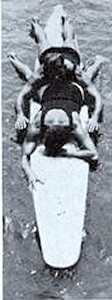
Here
the swimmer
is
paddled ashore.
|
IN “BODY
SURFING”—riding waves without a board—the technique varies
from that practiced on the surfboards.
Although
very steep swells may be taken in this manner, most body
surfers elect to catch a wave just as it is breaking and
then travel with their heads and shoulders just ahead of the
“suds.”
Where the
breakers are not strong, you may find it a help to kick the
feet while under way, or to bend one or both legs at the
knees.
Some “body
surfers” prefer to extend their arms forward, but you will
note that under most circumstances the most proficient
performers will keep their arms close to their sides.
This
position allows the chest, which is the body’s region of
greatest buoyancy, to be as far as possible in advance of
the rolling water.
And now, as
we rest upon our surfboards, awaiting a green swell which
moves silently toward us, let us hail the cradle of the wave
rider — Hawaii.
May we
salute, also, that ancient island conquerer, King Kamehameha
I.
Legend tells
us that, even when old in years, he was a skillful wave
rider.
But surely
no man is old who can hitch his surfboard to the untamed
waves.
To him, and
to those other sunny-souled people of the islands, let us be
grateful for at least one secret of prolonging youth.

surfresearch.com.au
Geoff Cater
(2000-2013) : Paul Gartner : Surfboard Riding Hints, 1937.
http://www.surfresearch.com.au/1937_Gartner_PopSc_July.html










